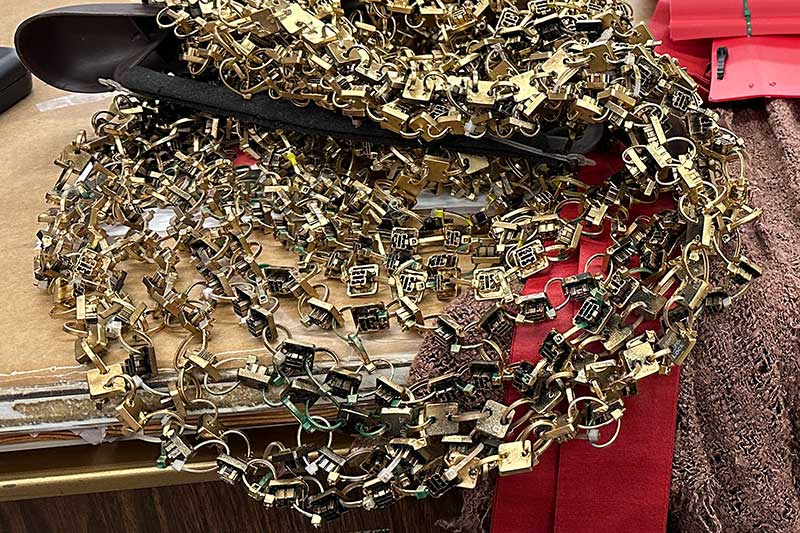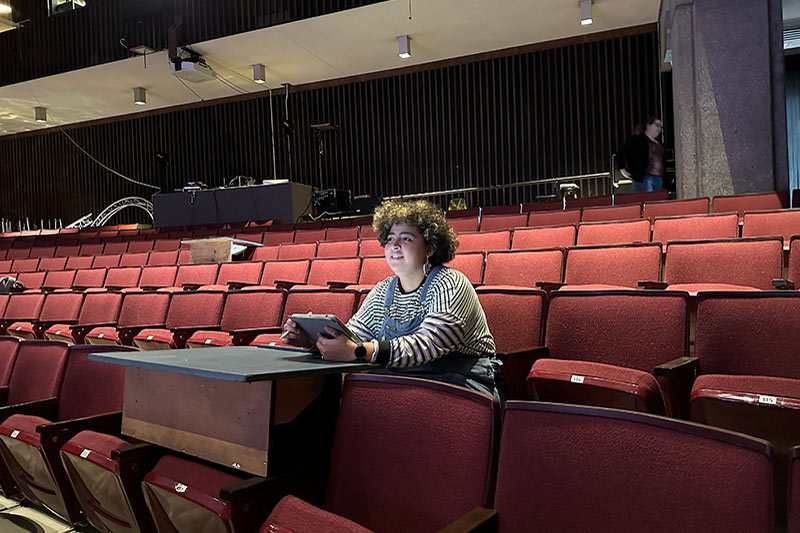MSU’s Department of Theatre and Dance will present “Mr. Burns: A Post-Electric Play” Feb. 29-March 4 in Coger Theatre, Craig Hall.
Assistant professor of theatre and dance Karen Sabo directs the play.
Show times are Feb. 29-March 2, 7:30 p.m. and March 3, 2:30 p.m. Tickets are $15 for adults, $12 for students and seniors. MSU students can receive special advance purchase discounts with an MSU ID.
A post-apocalyptic play with a quirky pop culture twist

“Mr. Burns” has been on Karen Sabo’s radar for some time.
“This is a play I’ve been pitching to places for quite a few years because I have wanted to direct it,” she said.
Sabo was intrigued both by the play’s storyline and its backstory.
“The playwright, Anne Washburn, was commissioned to write it about ten years ago by a New York City theatre group called The Civilians, and they asked her to explore what would happen to a pop culture narrative after a breakdown of society,” Sabo explained.
The resulting three-act play explores that “breakdown” by transporting audiences through 75 years in a post-apocalyptic society.
Most of the population has died, nuclear plants are unattended and leaking, and the electric grid is gone in this dreary world.
The survivors seek solace in performance. One of their immediate outlets is to reenact excerpts from the pop culture phenomenon “The Simpsons.”
Spanning generations to celebrate the dramatic impulse
Sabo and her assistant director, senior theater education major RyLea Clark, described “Mr. Burns” as a show that celebrates youth culture, theater history and the human dramatic impulse.
“I think it’s a perfect play to do on college campuses for students because it marries art and entertainment so well, and for all those students taking Intro-to-Theatre-type courses, it incorporates a lot of material they learn, such as about the universal human impulse to dramatize stories,” Sabo said.
“Everyone knows the Simpsons,” said Clark, highlighting the cross-generational relatability of the play’s subject matter.
Sabo’s production team was eager to start working on the creative aspects of the project in part because of that pop culture connection.
“They’re excited to work on the show because it legitimizes an element of pop culture, and that’s really important to the lives of young people,” Sabo said. “I know that TV shows, especially cartoons, can seem like meaningless ephemera, but they’re the stories of our times and represent who we are at this moment.”
Sustainable production inspires imagination and creativity
Sabo, whose parents were part of the “Back to the Land” movement of the 1970s, wanted sustainability to be a key part of the production of “Mr. Burns.”
She was inspired in part by an incident after a show she was working on as a young adult. When the production closed, the crew took all the production materials to a field and burned them.
“I remember thinking that even though it would take work to disassemble that set to reuse the materials, that would be sustainable both environmentally and possibly also financially,” Sabo said.
“I realized that I’d have rather volunteered to put a few hours in breaking down the set materials than attend the bonfire,” she added.
Sabo now serves as MSU’s Spring 2024 Sustainability Fellow and is a member of the Broadway Green Alliance, an organization dedicated to encouraging green initiatives in theaters.
“I thought becoming a Sustainability Fellow would be a great way to learn more about the subject and about how it’s taught here [at MSU], to learn more about sustainability initiatives on campus and to connect with like-minded students, staff and faculty,” Sabo said. “It’s been great so far!”
For the “Mr. Burns” production, Sabo instructed her team to focus on sustainability when creating and building costumes, sets and props.
“I’ve urged the designers and technicians to use as many found, reused and repurposed materials as possible, as it supports the nature of this show,” Sabo explained.

“It’s unavoidable that we buy some materials new and that we use some things that are made of Styrofoam or plastic,” she said. “But I’ve encouraged everyone to see what we already have that we can use first before we buy new stuff, which suits this play because it’s set after the electric grid has gone down so no one is manufacturing new plastic materials.”
“The characters ostensibly are just using what they find and making do, so if we do the same it supports the nature of this setting,” she added.
“And we’re under budget!”
Production team on board
The “Mr. Burns” production team has embraced Sabo’s sustainability mission.

Nearly 40 people – including student employees, cast members, students assigned to the show and students in lab classes – are involved in the technical and design aspects of the show, according to scene shop supervisor Anna Hunt.
Sabo has been pleased with their efforts.
“The students have been very imaginative and creative,” she said. “I love seeing what my colleagues, and especially the students, bring to the table creatively. Sometimes working with certain restrictions can encourage significant creativity.”
Like Sabo, Clark values the underlying focus of sustainability in their production of “Mr. Burns.”
“The sustainability message behind the production is important,” Clark said. “So much about ‘being with the times’ is defined by what we have. We see this even in theatre – elaborate stage productions when really all you need are 5 people and some chairs.”
The costume shop has proved particularly creative and efficient in their efforts to work with non-traditional materials. The challenge, Sabo said, has been for the costume team to put it all together.
“When you’re making costumes out of caution tape, keyboard keys and crushed soda cans, you have to figure out new ways to build the clothing,” she said.

Lucas Geisinger, a senior theater education major and designer of head gear (wigs, hair, etc.) for the show, has used Tupperware, bottoms of two-liter bottles, pencils, zip ties, “bendy” tubes, cardboard, spoons, pop cans and yarn—“lots of yarn,” he laughed—to build costume pieces.
Costume professor Eryn Brooks Brewer designed a medieval-like chain mail hood made of computer keyboard keys and zip ties, painted gold. It took the team a week and a half to construct the hood.
Lisa Simpson’s dress from Act III, made mostly of caution tape, was designed by Sarah Garner.
A belt for one character is decorated with crushed soda cans painted gold.
“I know that the people in the costume shop went hunting through recycling bins on campus to find some of the materials they need, and I hope that we’ve pulled materials to use from the set and prop warehouse even more with this play than with others,” Sabo said.
Geisinger and Morrow estimated about 60-70% of the materials they have used for costumes are recycled/repurposed.
Clark enjoys major stage production directorial debut
“Mr. Burns” represents Clark’s first time directing a major stage production.
As assistant director, Clark helps “bounce off ideas” with Sabo, reminds her of ideas they previously discussed and determines whether they still want to implement them. Clark also gives feedback on how the production is developing, such as design processes, staging and character.
“My definition of direction is directing ideas,” Clark said. “It’s more like asking questions [of the actors] than just telling someone to ‘go here’ or ‘stand there.’”
The directing role has been “a very interesting process to figure out,” Clark said. “Karen has been really open to ideas, and she’s very good at communicating what she is thinking.”
“It’s been a lot of fun.”

As far as the play itself, Clark believes “Mr. Burns,” despite its dark, post-apocalyptic scenario, is about hope, and she believes audiences will leave with that feeling.
“If people can create something this elaborate out of nothing, then there’s hope,” she said.
Sabo’s perspective on the play is similar.
“I hope they’ll find it compelling, moving, funny and meaningful,” she said. “I hope audiences will understand that the lives we live now, and the entertainment we produce and consume, are actually very meaningful regarding who we are as a people living in this time and place.”
Check out Theatre & Dance’s Spring 2024 Productions
Updated 5 March 2024.
Photos by Lynn Lansdown

